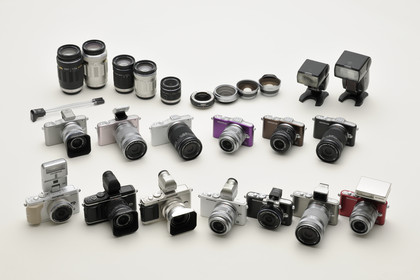TechRadar Verdict
Pros
- +
Detail-rich images at low ISO Fast AF Responsive touchscreen Loads of features Accessory port (for viewfinder)
Cons
- -
Poor images at ISO 6400 and above AF tracking can't keep up with fast movement No viewfinder built-in
Why you can trust TechRadar
Although from the outset Olympus's PEN series of compact system cameras had its fans, it also had its fair share of detractors. The E-P1 (launched in June 2009) for example, had no built-in flash or viewfinder, a dated and somewhat confused menu and a sluggish AF system.
Subsequent cameras went someway to deal with these points, but to the casual observer the models had little to distinguish themselves from each other.
With its recent announcement of the PEN E-P3, E-PL3 (L standing for Lite) and the E-PM1 (M for Mini), however, Olympus has attempted to deal with this identity crisis as well as make a few other improvements.
While sharing the same basic specs, the three new models are designed to appeal to different users. The PEN E-P3 sits at the top of the range and caters for advanced users, the E-PL3 is in the middle for those perhaps looking to upgrade from a high-end compact model, while the E-PM1 (Mini) is for photographers who want a very a compact camera that accepts interchangeable lenses.
The Olympus PEN E-P3, aka The PEN or P3, will be on sale at the end of August, but the Lite and Mini variants will be following in late early autumn.

Features
Like the PEN Lite and Mini cameras, the Olympus P3 has a Four Thirds type 17.3 x 13.0mm Live MOS (CMOS) sensor with 12.3 million effective pixels.
Olympus has a working agreement with Panasonic and the sensor in the new PEN camera hails from Panasonic's factories – it is believed to be the same sensor as in the Panasonic GF3.
Sign up for breaking news, reviews, opinion, top tech deals, and more.
As a compact system camera, the P3 has no reflex mirror, so it employs a contrast detection auto focus (AF) system that uses information from the imaging sensor. The Live MOS device inside the P3 has a fast read-out speed of 120fps, which helps to speed-up the AF.
Olympus claims that the TruePic VI processing engine in the new PEN cameras is faster than Panasonic's Venus Engine VI FHD device, so it can get more speed out of the AF system. Consequently, Olympus believes that the P3 has the world's fastest AF when used with its MSC (Movie Stills Compatible) optics.
Being a Micro Four Thirds model, the P3 can accept lenses with the Micro Four Thirds mount from Olympus and Panasonic.
In another upgrade to the PEN AF system, the P3 has 35 AF points, which cover all but the outer edges of the imaging frame. Helpfully, Olympus has also added an AF assist light to improve focusing in low light conditions. In addition to the usual single and continuous AF options, the P3 has a Tracking Continuous AF mode (like Panasonic's) that allows the user to specify the subject for focus and then leave the camera to keep it sharp as it moves around the scene.

Olympus clearly has faith in it TruePic VI processing engine's ability to control noise as the P3 has a sensitivity range that runs from ISO 200 to ISO 12,800, with ISO 3200 and above being listed as extension values.
Touchscreen
Touchscreens can be divided into two types, resistive and capacitive. Resistive screens have two electrically conductive layers that are separated by a narrow gap. When a finger or stylus presses these two layers together, the touch is detected and the device responds accordingly. Panasonic uses resistive touchscreens in its cameras.
Capacitive screens have an electrically conductive surface coating and touching this with human skin, which is also conductive, changes the capacitance and triggers a response. Apple uses a capacitive screen in its iPhones.
Devices with capacitive screens cannot be controlled by non-conductive styluses etc, but they tend to be more responsive to finger-touch than resistive screens as they require only a touch rather than a press.
In a first for the Olympus PEN system, the P3 has a touchscreen. This is a 3in 610,000dot OLED device and unlike other cameras that have a resistive screen, the P3's is capacitive like the screen on an iPhone.
Though it may seem unnecessary to some, when well implemented a touchscreen can really improve a camera's handling by allowing quicker access to features and more intuitive control. The E-P3 features touch AF, which instructs the camera to focus on the point in the scene chosen by a touch of a finger, and, like the Panasonic G3 and GF3, it also has a touch shutter. This sets the camera to focus and fire the shutter with a touch of a finger on the screen.
Helpfully, Olympus has given the P3's screen an Anti-Fingerprint Coating that should reduce the amount of smudging on its surface.
Although it doesn't have a viewfinder built-in, the P3 has an accessory port (see below) to accept Olympus's optional external electronic viewfinder (EVF). The Viewfinder slots into the P3's hotshoe, which means it can't be used with an external flashgun, but the P3 also has a flash unit built-in.

Another welcome inclusion with the P3 is a two-axis electronic level, which is useful when it's essential to keep the horizon level and it operates when the camera is upright or in landscape format.
While the P3 has lots to offer enthusiast photographers, there are lots of automated modes that help out less experienced photographers. Olympus's Live Guide, for example is on hand and works with the touchscreen. The popular Art Filters are also available and can be used completely automatically or in any of the advanced shooting modes. Video can also be recorded in AVCHD or Motion JPEG format.
